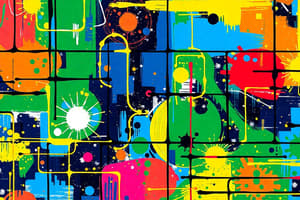Podcast
Questions and Answers
What is the primary function of the Transport Layer?
What is the primary function of the Transport Layer?
- Data formatting and encryption
- Routing and congestion control
- Segmentation and reassembly (correct)
- Process-to-process communication
Which protocol is associated with the Session Layer?
Which protocol is associated with the Session Layer?
- TCP
- IP
- SSH (correct)
- HTTP
What is the primary function of the Physical Layer?
What is the primary function of the Physical Layer?
- Error detection and correction
- Segmentation and reassembly
- Data compression and encryption
- Bit transmission and reception (correct)
Which layer is responsible for providing services to end-user applications?
Which layer is responsible for providing services to end-user applications?
What is the primary function of the Data Link Layer?
What is the primary function of the Data Link Layer?
Which protocol is associated with the Network Layer?
Which protocol is associated with the Network Layer?
Flashcards are hidden until you start studying
Study Notes
OSI Layers Overview
The OSI (Open Systems Interconnection) model is a 7-layered framework for designing and implementing computer networks.
Layer 7: Application Layer
- Provides services to end-user applications
- Functions:
- Process-to-process communication
- Data formatting and encryption
- Protocols:
- HTTP, FTP, SMTP, DNS
Layer 6: Presentation Layer
- Converts data into a format that can be understood by the receiving device
- Functions:
- Data compression and encryption
- Data formatting
- Protocols:
- SSL, TLS
Layer 5: Session Layer
- Establishes, manages, and terminates connections between applications
- Functions:
- Session establishment and termination
- Dialogue management
- Protocols:
- NetBIOS, SSH
Layer 4: Transport Layer
- Provides reliable data transfer between devices
- Functions:
- Segmentation and reassembly
- Error detection and correction
- Protocols:
- TCP, UDP
Layer 3: Network Layer
- Routes data between networks
- Functions:
- Routing and congestion control
- Addressing and packet forwarding
- Protocols:
- IP, ICMP, IGMP
Layer 2: Data Link Layer
- Provides error-free transfer of data frames between nodes
- Functions:
- Framing and error detection
- Flow control and multiplexing
- Protocols:
- Ethernet, Wi-Fi, PPP
Layer 1: Physical Layer
- Defines the physical means of transmitting data
- Functions:
- Bit transmission and reception
- Cable specification and wireless transmission
- Protocols:
- RJ-45, Wi-Fi, Bluetooth
OSI Layers Overview
- The OSI model is a 7-layered framework for designing and implementing computer networks.
Layer 7: Application Layer
- Provides services to end-user applications, enabling process-to-process communication.
- Performs data formatting and encryption.
- Supports protocols such as HTTP, FTP, SMTP, and DNS.
Layer 6: Presentation Layer
- Converts data into a format that can be understood by the receiving device.
- Performs data compression and encryption.
- Performs data formatting.
- Supports protocols such as SSL and TLS.
Layer 5: Session Layer
- Establishes, manages, and terminates connections between applications.
- Manages session establishment and termination.
- Manages dialogue between applications.
- Supports protocols such as NetBIOS and SSH.
Layer 4: Transport Layer
- Provides reliable data transfer between devices.
- Performs segmentation and reassembly of data.
- Performs error detection and correction.
- Supports protocols such as TCP and UDP.
Layer 3: Network Layer
- Routes data between networks.
- Performs routing and congestion control.
- Manages addressing and packet forwarding.
- Supports protocols such as IP, ICMP, and IGMP.
Layer 2: Data Link Layer
- Provides error-free transfer of data frames between nodes.
- Performs framing and error detection.
- Performs flow control and multiplexing.
- Supports protocols such as Ethernet, Wi-Fi, and PPP.
Layer 1: Physical Layer
- Defines the physical means of transmitting data.
- Performs bit transmission and reception.
- Specifies cable and wireless transmission.
- Supports protocols such as RJ-45, Wi-Fi, and Bluetooth.
Studying That Suits You
Use AI to generate personalized quizzes and flashcards to suit your learning preferences.




